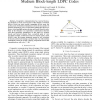Free Online Productivity Tools
i2Speak
i2Symbol
i2OCR
iTex2Img
iWeb2Print
iWeb2Shot
i2Type
iPdf2Split
iPdf2Merge
i2Bopomofo
i2Arabic
i2Style
i2Image
i2PDF
iLatex2Rtf
Sci2ools
WCNC
2008
IEEE
2008
IEEE
Cooperative Communications Using Scalable, Medium Block-length LDPC Codes
Abstract— Cooperative communications has received increasing attention in recent years because of the ubiquity of wireless devices. Each year more mobile computing devices enter the market, most of which have limitations in terms of size, number of antennas and battery power. Cooperation enables these devices to form a virtual multiple antenna system and benefit from diversity. Most of the literature on cooperation is information theoretic with often unrealistic assumptions. In this paper we examine decode and forward scheme from a practical point of view and utilize scalable, architecture-aware low density parity check (LDPC) codes. We present simulation results for two variations of decode and forward strategy and show that even with realistic assumptions about the system, relaying outperforms direct link communications with over 2.5 dB.
Density Parity Check | Mobile Computing Devices | Virtual Multiple Antenna | WCNC 2008 | Wireless Networks |
| Added | 01 Jun 2010 |
| Updated | 01 Jun 2010 |
| Type | Conference |
| Year | 2008 |
| Where | WCNC |
| Authors | Marjan Karkooti, Joseph R. Cavallaro |
Comments (0)

